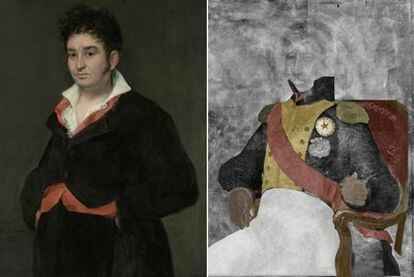Peeling back the layers of a Goya
Dutch museum's chemical analysis reveals Aragonese maestro's original Napoleonic intentions
A Goya on top of another Goya. That is what the Rijksmuseum in Amsterdam discovered after analyzing the Portrait of Don Ramón Satué , which the Aragonese artist painted in 1823. The finding was made possible through a new chemical analysis technique based on fluorescent X-rays, known as Scanning Macro X Ray-Fluorescence Spectrometry.
Using a portable scanner, researchers peered under the layers of oil paint and found an entirely different portrait underneath - of an officer in Napoleon's army. His face, concealed until now, is not well defined. But the cavalry uniform and his medals suggest a general. It could even be Joseph Napoleon, king of French-occupied Spain and Napoleon Bonaparte's older brother.
"With the moving scanner, we can go to the museum and analyze all the layers of paint. That is how we rebuild the colors lying below the image that the public sees. And all that, without hardly touching the canvas," says Joris Dik, of the Delft Technical University, whose team has developed the technology in tandem with the Belgian University of Antwerp. The work they do is similar to an archeologist's, except they painstakingly write the history of a painting through its pigments.
For the Rijksmuseum, it's quite a discovery. The Portrait of Don Ramón Satué is the only Goya piece kept in a Dutch art gallery. Presented like a treasure, the history of this artwork is closely linked to the history of Spain. Satué was a judge and a minister of the Council of the Indies, the main administrative body of the Spanish territories in the Americas and the Philippines. He came from a family of prominent clerics and his brother was a canon of the basilica of El Pilar in Zaragoza. According to Dutch experts, Goya must have painted the French official between 1808 and 1813. After the Spanish War of Independence from France, the painting was left behind when Napoleon's troops beat a retreat in 1813.
Years later, Goya painted Satué over the Frenchman's portrait. After all, he could have been compromised by this unfinished portrait of a Napoleonic invader. Goya had supported the liberal Constitution of 1812, which Fernando VII swore to uphold in 1820. When the king, following the Liberal Triennium, was reinstated in 1823 as an absolute monarch, Goya hid in Satué's house. In time, that second portrait would go on to become one of the most valuable pieces in the artist's extensive production.
For now, the artwork in question is hanging temporarily at the Boymans-van Beuningen museum in Rotterdam. In 2013, when the restoration work on the Rijksmuseum is completed, the Portrait of Don Ramón Satué will return to the Dutch capital.
The Rijksmuseum has never allowed the piece to travel to Spain, alleging conservation issues - not even when the request came from the Prado Museum itself.











































